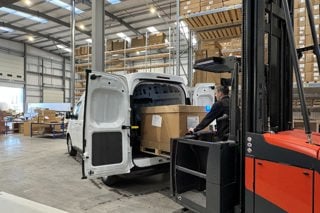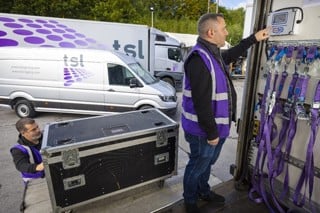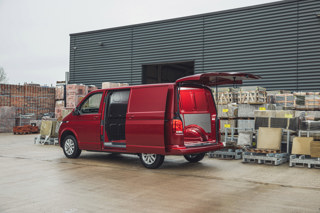Commercial fleet operators are being warned that vital safety technology on new vans is being undermined by overloading.
Manufacturers are offering increasing levels of safety on the latest light commercial vehicles (LCVs), with one in four vans currently on sale in the UK available with advanced collision warning systems.
Three new models launched at last month’s Commercial Vehicle Show – Citroën Dispatch, Peugeot Expert and Toyota Proace – now feature autonomous emergency braking.
However, for all the benefits advanced safety tech brings, the SMMT says that an overloaded or poorly loaded van can still pose a risk to its driver and other road users, adding vital metres to braking distances and affecting handling.
SMMT chief executive Mike Hawes said: “Manufacturers are investing significant amounts in new safety technology, but this can only do part of the job.
“We continue to urge operators and owners to comply with the law to keep themselves and others safe, avoid the risk of fines and keep the threat of further legislation at bay.”
Almost nine in 10 (88.5%) of the 2,381 vans weighed last year by the DVSA were found to be overloaded, a worse record than the previous year, in which 84% of the 3,337 checked were illegal.
A survey of both fleet managers and van drivers, commissioned by Volkswagen Commercial Vehicles, found that nearly half of UK businesses don’t monitor the weight of their company vehicles, and 53% of drivers don’t know their vehicle’s maximum load carrying capacity.
If a vehicle is found to be in breach of its legal maximum weight, a fixed penalty fine will be issued.
The amount of the fine will depend on how much the vehicle is over the legal limit.
An excess of between 5-10% will result in a £100 fine; 10-15% equates to a £200 penalty; and 15-30% will cost £300. More than 30% and a court summons will be issued.
In most situations that will result in a fine, if found guilty, of up to £500.
But if the van has been overloaded to the point where it is a real hazard to other road users, a dangerous driving charge could follow.
While anyone operating a heavy goods vehicle (HGV) is subject to strict rules under the operator licensing regime, this does not apply to vehicles up to 3.5 tonnes – the vast majority of vans.
No move has yet been made to extend operator licensing to vans and to ensure this, plus a potential £2.6 billion in extra costs for operators continues to be avoided, industry is keen to see this safety record improve.
Gordon Macdonald, DVSA compliance service manager, said: “Overloading continues to be a real issue, and drivers and businesses need to carefully consider their legal responsibility towards vehicle weight compliance, so we fully support the SMMT’s latest important van safety message.”
The warning comes in the wake of statistics from the SMMT that show the number of vans on UK roads has hit an all-time high of four million. The van parc has hit 4,007,331, a 4.3% increase on the previous year.
Hawes said: “Commercial vehicles have never been more important to the British economy, transporting vital goods and services using the latest low emission technology.”
Demand for new vans in the UK is at record levels: registrations grew 1.2% in the first quarter of 2016, following a bumper 2015 which saw more than 370,000 units registered.
The increasing uptake of new vans is also good news for the environment, says the SMMT, with all vans registered from September this year having to meet strict Euro 6 emissions regulations.
These vehicles feature advanced filters, which capture 99% of particulates, as well as exhaust after-treatments to cut emissions of NOx.
This has paved the way for the launch of a record number of new models at this year’s CV Show, as manufacturers meet higher demand for vans and pickups across the UK and Europe.
“This further demonstrates the continued growth of vans and their importance to the UK economy in supporting online and entrepreneurial activity,” said Mark Cartwright, head of vans at the Freight Transport Association (FTA).
“However, it is incumbent on operators of all sizes and sectors to ensure that they operate their vehicles in a safe, compliant and efficient manner.”






















Login to comment
Comments
No comments have been made yet.